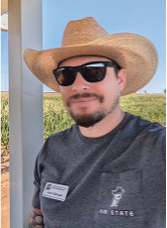Guide Z-131
Jason Banegas
College of Agricultural, Consumer and Environmental Sciences, New Mexico State University
Author: Extension Economist and Statewide Forecasting Specialist, College of Agriculture Economics & Agricultural Business, New Mexico State University. (Print-friendly PDF)

Cochliomya homnivorax (New World Screwworm), by Judy Gallagher, 2017.
CC BY 2.0 via Wikimedia Commons.
Introduction
The return of a pest once eliminated from the U.S. poses a renewed threat to the health of our livestock and the stability of our markets. This guide explains why New Mexico ranchers should be alert and what can be done to protect their operations.
What is the New World Screwworm?
New World Screwworm (NWS, Cochliomyia hominivorax) is a parasitic fly whose larvae infest warm-blooded animals. What makes NWS especially dangerous is that it feeds on healthy, living tissue. Unlike most flies that infest decaying matter, NWS larvae grow inside fresh wounds; even small cuts or branding injuries can attract the pest, and treatment is costly and time sensitive. The infestation, known as myiasis, causes intense pain, infection, weight loss, reduced production, and potentially death if untreated. NWS primarily feeds on mammals but can also affect birds.6
Screwworm was eradicated from the U.S. in the late 1950s and 1960s using the Sterile Insect Technique (SIT). “Since 1994, the United States and Panama have collaborated on a project to drop millions of sterile flies over a jungle area at the Panama-Colombia border to keep the fly from spreading northward.”4 In 2016, an outbreak of NWS in the Florida Keys prompted an urgent response, including the release of sterile flies and the establishment of quarantine zones. Had the infestation reached the mainland, it could have caused severe economic damage to cattle industries throughout the Gulf Coast region.
Why This Matters Now
The reemergence of New World Screwworm (NWS) in southern Mexico in November of 2024 prompted the U.S. Department of Agriculture’s Animal and Plant Health Inspection Service (USDA-APHIS) to close the U.S.-Mexico border to livestock imports. This biosecurity measure was an attempt to protect the U.S. livestock industry from a pest that can cause devastating economic losses. “The North American Invasive Species Management Association (NAISMA) called the detection of NWS a serious threat to the United States as well as Mexico.”2
The border reopened in February 2025 after “APHIS and Mexico agreed to and implemented a comprehensive pre-clearance inspection and treatment protocol to ensure safe movement and steps to mitigate the threat of NWS”9, but on May 11, 2025, livestock imports along the southern border were again suspended after a rapid northward spread of the pest.
Why New Mexico Producers Should Be Concerned
“The border closure will create economic harm for U.S. farmers and ranchers, and create supply chain disruptions, but the costs will be far less than if NWS crosses into the United States and we’re forced to fight the pest on U.S. soil.”1 New Mexico’s livestock economy is closely tied to trade with Mexico and the border closure has specific implications:
- Trade Disruption: In 2024, no cattle were imported in the last five weeks of the year. “Thus far in 2025, a total of 197,844 head of feeder cattle have been imported since the border reopened, down 60 percent year over year for the year-to-date.”3
- Market Volatility: Reduced cattle imports affect supply chains and feeder cattle markets, possibly increasing prices nationally due to tighter supplies or reducing them locally due to backlogs in marketing options. In New Mexico many producers depend on a steady inflow of Mexican cattle to meet demand and maintain throughput in operations. When imports are disrupted, local markets experience logistical bottlenecks, while downstream buyers may face inventory shortages and rising procurement costs.
- Increased Operating Costs: Backlogged or rerouted livestock increases feed, labor, and transport costs for producers on both sides of the U.S.-Mexico border, particularly in areas where operations rely on timely access to Mexican cattle to fill grazing leases and feedlot pens. Delays caused by border closures can result in overcrowding, extended holding periods, and higher input costs at staging areas.
Estimated Economic Impacts
Prior to the eradication of NWS, livestock producers in both the southeastern and southwestern United States suffered significant economic losses due to recurring infestations. Losses were especially high in the Southwest, likely because of its larger cattle populations, expansive rangeland, and climate conditions that favored year-round screwworm survival.7 If the pest were to spread again, producers could face stricter inspection protocols, more frequent animal health checks, and tighter shipping restrictions. These factors would significantly increase production and marketing costs under current economic conditions.
Calculating a cost to New Mexico producers is difficult but some comparisons can be made using estimates of a USDA guide from January 2025. The guide states that the “results of adjusting for inflation indicate that an NWS outbreak roughly the scale of the 1976 outbreak could cost Texas producers $732 million per year and the Texas economy a loss of $1.8 billion.”7 Texas’s cattle inventory is approximately 8.7 times larger than New Mexico’s with cash receipts of $13.37 billion versus $1.71 billion, and their milk production is about three times as much with receipts of $3.36 billion versus $1.23 billion. The estimated cost to Texas producers was calculated at approximately 4.4% of cash receipts for these livestock products, so a comparable impact for New Mexico producers would be approximately $128 million. Additionally, the potential total economic loss to Texas is estimated to be 10.8% of cash receipts, so an equitable impact in New Mexico would be $316 million. Table 1 demonstrates this data.
|
Table 1. New Mexico and Texas Livestock Data and NWS Impacts10,11 |
||
|---|---|---|
|
Metric |
Texas |
New Mexico |
|
Cattle Inventory (Jan 1, 2025) |
12.2 million head |
1.280 million head |
|
Milk Production (2024) |
15.6 billion pounds |
8.1 billion pounds |
|
Cattle & Calves Cash Receipts (2023) |
$13.37 billion |
$1.71 billion |
|
Dairy Products, Milk Cash Receipts (2023) |
$3.36 billion |
$1.23 billion |
|
Estimated cost to producers |
$732 million |
$128 million |
|
Estimated cost to the state |
$1.8 billion |
$316 million |
The cost of maintaining the sterile fly barrier may be high but is far lower than the economic fallout of a domestic outbreak. Between the 1990s and 2016, NWS eradication efforts yielded $796 million/year in producer benefits and $2.8 billion/year in general economic benefits.7 Those benefits are estimated to be higher today with approximately $1 billion in direct benefits to livestock producers and approximately $3.7 billion in yearly benefits to the U.S. economy.5 At the end of 2024 USDA APHIS announced $165 million in emergency funding to protect U.S. livestock and other animals from NWS and to increase USDA’s ongoing efforts to control the spread of NWS in Mexico and Central America.8
Risk Mitigation Strategies for Producers
New Mexico ranchers can take proactive steps to reduce NWS risks and manage the impacts of the border closure:
- Animal Health Monitoring
NWS larvae target open wounds and can spread quickly. Regularly inspect livestock for wounds and unusual fly activity, particularly after procedures like branding, dehorning, or calving. - Wound Management
Use antiseptics, wound dressings, and approved insecticides immediately on all cuts and abrasions. Keeping wounds clean deters egg-laying. - Quarantine New Animals
Prevent introducing infected livestock into your herd, especially those from high-risk regions. - Report Suspicious Cases
Suspected NWS infestations must be reported to local veterinarians, the State Veterinarian, or USDA-APHIS immediately. Additionally, contact the New Mexico Livestock Board at 505-841-6161 or 505-414-2811 for livestock infestations. Report suspected wildlife cases to the New Mexico Department of Game & Fish at 505-690-3208. Human cases should be reported to the New Mexico Department of Health at 833-796-8773. Early detection prevents wider spread. - Reevaluate Grazing and Marketing Plans
With cross-border grazing or livestock movement disrupted, explore alternative pastures, water sources, or delayed marketing timelines.
Likely Outcomes and Long-Term Outlook
USDA and Mexican officials will continue to monitor the outbreak and decide month-to-month whether it is safe to reopen the border.9 If containment in Mexico is successful, the USDA may reopen the border later in 2025 with protocols in place. Daniel Manzanares, director of the Santa Teresa International Export/Import Livestock Crossing, told Beef Magazine in November of 2024 that protocols to reopen the border would include measures such as: The Mexican government establishing “pre-export” pens to hold cattle where cattle for export will be inspected and kept in quarantine for seven days after being treated with Ivermectin. Once the quarantine is over, they can be moved to approved border ports in Sonora and Chihuahua. At the ports, the cattle will be dipped following standard procedures and inspected by USDA-APHIS veterinarians before being transported to the U.S.2 Similar protocols can be expected with this new reemergence.
However, if NWS spreads further north, long-term closures, stricter inspection protocols, and even domestic control zones could be imposed. The worst-case scenario would be the reestablishment of NWS in the U.S., which would lead to massive surveillance and treatment costs for ranchers, restricted market access, and years of economic recovery.
Conclusion
NWS is a preventable threat that requires vigilance and investment. New Mexico livestock producers should prepare for the continued border disruption while prioritizing herd health and biosecurity. Collaboration with veterinarians, NMDA representatives, and NMSU extension agents will be crucial in managing the risks.
References
- National Cattlemen’s Beef Association. (2025, May 11). NCBA Stands with USDA on Border Closure Decision. National Cattlemen’s Beef Association. https://www.ncba.org/news-media/news/details/43036/ncba-stands-with-usda-on-border-closure-decision
- Peck, C. (2024, November 28). Screwworms Impacting Cattle Trade. BEEF Magazine. https://www.beefmagazine.com/livestock-management/screwworms-impacting-cattle-trade
- Peel, D.S. (2025, May 12). Mexican Border Closes Again. Cow-Calf Corner, Oklahoma State University. https://extension.okstate.edu/programs/beef-extension/cow-calf-corner-the-newsletter-archives/2025/may-12-2025.html
- Shnirring, L. (2025, May 12). USDA Suspends Southern Border Livestock Imports Over New World Screwworm Threat. Center for Infectious Disease Research and Policy, University of Minnesota. https://www.cidrap.umn.edu/misc-emerging-topics/usda-suspends-southern-border-livestock-imports-over-new-world-screwworm
- Texas Animal Health Commission. (2024, November 2). New World Screwworm Current Outbreak [Situation Report]. https://tscra.org/wp-content/uploads/2024/11/2024-11-2_NWS-SituationReport.pdf
- Texas Animal Health Commission. (2024, November). New World Screwworm [Factsheet]. https://www.tahc.texas.gov/news/brochures/TAHCFactsheet_NewWorldScrewworm.pdf
- USDA Animal and Plant Health Inspection Service. (2025). New World Screwworm: Ready Reference Guide – Historical Economic Impact. https://www.aphis.usda.gov/sites/default/files/nws-historical-economic-impact.pdf
- USDA Animal and Plant Health Inspection Service. (2024, December 13). USDA Approves Emergency Funding to Protect U.S. Livestock and Animals from New World Screwworm. https://www.aphis.usda.gov/news/agency-announcements/usda-approves-emergency-funding-protect-us-livestock-animals-new-world
- USDA. (2025, May 11). Secretary Rollins Suspends Live Animal Imports Through Ports of Entry Along Southern Border, Effective Immediately [Press Release No.: 0105.25]. https://www.usda.gov/about-usda/news/press-releases/2025/05/11/secretary-rollins-suspends-live-animal-imports-through-ports-entry-along-southern-border-effective
- USDA Economic Resource Service. (2025, February 6). Farm Income and Wealth Statistics - Cash Receipts by Commodity State Ranking. https://data.ers.usda.gov/reports.aspx?ID=4058#Pe3db8f15b2c6453cb1c95b7ac1a552e2_9_251iT0R0x48
- USDA National Agricultural Statistics Service. (2025, January 31). Cattle Report. ISSN: 1948-9099. https://downloads.usda.library.cornell.edu/usda-esmis/files/h702q636h/sf26b275x/h989sz55j/catl0125.pdf
Lee esta publicación en español

Jason Banegas is an NMSU Extension Economist specializing in statewide forecasting. He earned a master’s degree in economics from the University of Oklahoma and is in the NMSU Doctor of Economic Development program and the NMSU Water Science and Management Ph.D. program. His Extension work provides current research-based information to New Mexico livestock and crop producers to enhance profitability and farm and ranch sustainability. With input from producers, industry representatives, researchers, extension agents, and other stakeholders he transforms data into usable guides and tools.
To find more resources for your business, home, or family, visit the College of Agricultural, Consumer and Environmental Sciences on the World Wide Web at pubs.nmsu.edu.
Contents of publications may be freely reproduced, with an appropriate citation, for educational purposes. All other rights reserved. For permission to use publications for other purposes, contact pubs@nmsu.edu or the authors listed on the publication. New Mexico State University is an equal opportunity employer and educator. NMSU and the U.S. Department of Agriculture cooperating.
May 2025. Las Cruces, NM.


